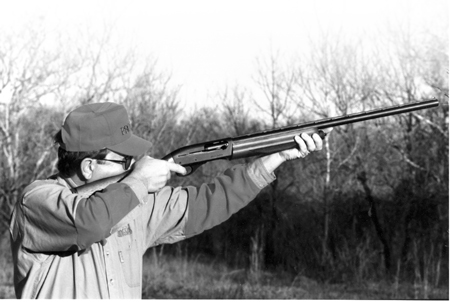
Hundreds of thousands of these popular shotguns have been sold over the decades, and the reason for that is simple: they are good guns. But is that used Remington 1100 being sold for a song, or to a sucker? Here are a few things to check.
Remington’s 1100 self-loading shotgun has seen a lot of changes over the years, some fairly major and some minor, though important nonetheless. If you’re in the market for a used one during the current Obama-pression, it’s a good idea to check on a few things before you hand over portraits of my favorite president, Ben Franklin.
Here’s what to look for Before You Buy:
Getting Started
As you unscrew the magazine cap, always be prepared for the magazine-spring retainer to be missing. If it is, the magazine spring can shoot the cap more than 20 feet and damage whatever it hits. Even if the retainer is in place, the spring has been known to come out on its own after the cap is removed. Something to watch for.
Rust in the extractor-plunger hole can create ejection problems and ultimately cause the destruction of the breech bolt. It’s worth checking early in the evaluation process. Rust doesn’t mean the gun is a dud, but it is a concern.
A Hard Kicker?
Excessive recoil from an 1100 can be a sign of improper mating between the barrel and the rest of the gas system. The problem can be caused by either too much gas pressure or too little.
Excessive pressure will open the breech too quickly while there is too much pressure still in the barrel, allowing the breech to blow back so hard that it gives excessive kick. Swelling of the fired shell is a sign of the breech’s opening early and showing excessive gas flow.
Insufficient gas pressure allows the breech to remain locked too long, giving the shooter the same recoil of a pump or other locked-breech shotgun. Low pressure often leads to a short stroke of the action. This will show up as improper or soft ejection and other feeding problems. Cleaning the gas ports will sometimes take care of this.
Seal Check
Always check the barrel seal to be sure the piston and piston seal are on right. The piston seal goes on first, with the flat base fitting snug against the front face of the action-bar assembly and the angle cut facing the muzzle.
The gas piston goes on next, with its angle cut facing into the matching angle of its seal. The rubber barrel seal then goes on, and should fit the magazine tube tightly. When slipped down to the notch in the magazine tube, it will still be tight. These seals need to be replaced if they are frayed, flattened, or stretched. Many owners will stretch these onto the front flat edge of the piston, or put them on in the wrong assembly order.
Check the Operating Handle
A common complaint of 1100 owners is that the operating handle comes out too easily and gets lost, or that it sometimes is too hard to get out. It is the operating-handle plunger that holds it, and this is part of the action bar.
Make sure the operating handle is cut or slotted to fit the bar; it may have been changed. Next, check the slots or cup-shaped hole in the bottom of the operating handle to make sure they are clear and clean.
Slip the handle into the action bar and see how much play it has. If it is too loose, it will need to be replaced with a thicker one. If it is tight, but still comes out too easily, the operating-handle plunger is not holding it tightly enough. The cup-shaped hole will need to be cleaned.
Doggin’ It
Some of the more common problems are stuck carrier-dog followers, which will lead to failures to feed. A bent carrier latch will not lift a second shell to the chamber when the shotgun is fired, even though it may work fine while working it by hand.
When the carrier dog is worn or loose on the base of the carrier, it will get the shotgun out of proper cycle and jam the action. If the front edge is worn excessively or bent, it will keep the trigger from engaging as it is supposed to, and will create jams.
Taking Stock of the Gun
The 1100 generally has the same types of external features as other shotguns and its ribs, beads, stocks, and forearms need the same maintenance and care.
Stocks are often replaced on these shotguns without the stock-bearing plate being properly reinstalled between the receiver and the stock. This creates chipped or broken stocks that must be repaired or replaced. Leaving off the action-tube spring nut washer or lock washer prevents the stock from properly fitting.

Next Step: Get your FREE Printable Target Pack
Enhance your shooting precision with our 62 MOA Targets, perfect for rifles and handguns. Crafted in collaboration with Storm Tactical for accuracy and versatility.
Subscribe to the Gun Digest email newsletter and get your downloadable target pack sent straight to your inbox. Stay updated with the latest firearms info in the industry.

![Best Concealed Carry Guns In 2025 [Field Tested] Wilson Combat EDC X9S 1](https://gundigest.com/wp-content/uploads/Wilson-Combat-EDC-X9S-1-324x160.jpg)


![Best 9mm Carbine: Affordable PCCs [Tested] Ruger Carbine Shooting](https://gundigest.com/wp-content/uploads/Ruger-Carbine-Shooting-100x70.jpg)
![Best AR-15: Top Options Available Today [Field Tested] Harrington and Richardson PSA XM177E2 feature](https://gundigest.com/wp-content/uploads/Harrington-and-Richardson-PSA-XM177E2-feature-100x70.jpg)
